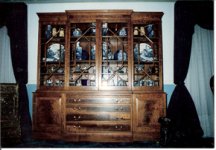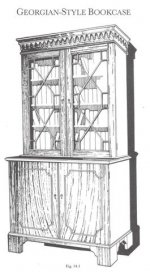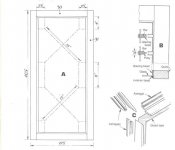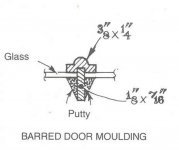Howard et al,
Guess I'm returning to this thread a little late, but thought it might be of some interest to broaden the context of this discussion to include some barred glass doors of pieces from other eras. My source for this is E. J. Warne's book, _Furniture Mouldings_, which happens to include full-sized drawings of mouldings of English furniture from 1574 to 1820. Included among those mouldings are the mouldings/bars of glazed doors from 1690 (actually 1675, but I believe it to be a joiner's piece) to 1790.
Here is a brief description and overall dimension of each piece, along with the width of the "astragal", or moulded portion of the glazing elements.
ca. 1690 Walnut China Cabinet, 4' wide by 6'6" high -- 3/4" wide moulding.
ca. 1720 Yellow Lacquer Bureau/Bookcase, 2' 2 3/4" wide by 5' 9 3/4" high -- 7/16" wide moulding.
ca. 1735 Spanish Mahogany Bookcase, 4' 7" wide by 7' 7 1/2" high -- 1" wide moulding.
ca. 1735 Mahogany Bookcase, 5' 1" wide by 7' 6" high -- 1" wide moulding.
ca. 1750 Mahogany Library Bookcase, 10' 6" wide by 8' high -- 11/16" wide moulding.
ca. 1750 Mahogany Library Bookcase, 9' wide by 7' 3" high -- 5/8" wide moulding.
ca. 1765 Mahogany China Cabinet, 4' 10" wide by 5' 5 1/2" high -- 13/32" wide moulding.
ca. 1780 Satinwood Bookcase, 3' 11" wide by 7' 2 1/2" high -- 7/16" wide moulding.
ca. 1785 Satinwood Escritoire Bookcase, 2' 11 13/16" wide by 6' 11" high -- 5/16" wide moulding.
ca. 1790 Mahogany Corner Cabinet, ca. 3' 6" wide by 7' high -- 15/32" wide moulding.
ca. 1790 Mahogany Bookcase, 5' 9 3/4" wide by 7' 8 1/4" high -- 3/8" wide moulding.
It would seem that the visual weight of these "astragals" could vary quite a bit, depending on the size and visual weight of other elements of each piece.
I think it may be of some interest to note that the bead moulding of the 1690 Walnut China Cabinet is cross-grained. As were all the mouldings on high-end pieces of that period. I can only speculate, but can't help but wonder if this feature played a role in the development of the two-piece construction used in barred glass cabinet doors of the 18th century and beyond. If the slats/bars were long-grain, they would have provided strength/integrity for the cross-grain walnut bead at the front.
Speaking of strength, I have no doubt that the glass stiffens the door to help keep it from sagging with the added weight, but my experience with doors of this construction has satisfied me that these doors are surprisingly strong, without the glass, when properly done. For example, in doors with "hexagonal" features, the three-way corners can be accomplished by mitering two elements then bracing that corner with a V joint on the end of the third element. Add the "astragal" and re-enforce with cotton or linen tape (or scrim), and it is satisfyingly rigid and strong.
Don McConnell
Eureka Springs, AR




